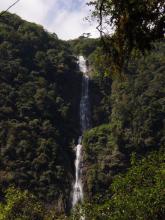Explore Bhutan Cultural Library

This collection contains essays on various genres of oral traditions in Bhutan, as well as other cultural subjects. Each text is linked to relevant places and subjects, such that users can explore the rich tapestry of Bhutanese culture through different media.
Texts in this collection
The list below includes texts from this Collection’s Subcollections.
A view on the history, nomenclature, and traditional social organization of Ura, one of Bumthang district's four valleys.
A translation of a prayer for the long life of the Fourth King of Bhutan Jigme Singye Wangchuck (b. 1955) composed by the 70th Je Khenpo Jigme Choedra.
An overview of the eight types of Alo, secular songs of sorrow sung solo and generally alone.
The history and development of archery as Bhutan's national game, played almost exclusively by men.
An extremely brief summary of Bhutan's religious history, presented in three phases.
A view on the building plans and cultural perceptions of temples built in Bhutan meant to emulate Guru Rinpoche's Copper Mountain Paradise.
Descriptions of the three types of water sources used for bathing in Bhutan: tshachu, menchu, and drupchu.
The author's view on the state of bomena and its changed prominence and practices in modern Bhutan.
A summary of the rationale for Buddhist practitioners' taking refuge, the proper steps for doing so, and the role of refuge in the Buddha, Dharma, and Sangha.
Chag or prostration is fundamentally a practice of paying respect, but it is not about submission to others. It is aimed at getting rid of one’s greatest flaw, evil and enemy--the ego or the sense of I.
This piece was initially published in Bhutan’s national newspaper Kuensel in a series called "Why we do what we do".
An overview of the Chagya Chenpo (phyag rgya chen po), or Mahāmudrā, from the Bhutanese perspective.
Cham is a type of sacred dance unique to the Indo-Himalayan Buddhist culture. It is an extension of the Buddhist practice of visual offering of aesthetic movement, the mudra expression of enlightened spirit and of the artistic and entertaining expedience of passing a spiritual message.
This piece was initially published in Bhutan’s national newspaper Kuensel in a series called "Why we do what we do".
The making of and uses for changkoe, a grain-based alcoholic foodstuff served at special occasions in Bhutan.
Mani is a popular ngag or mantra. Mani or oṃ maṇi padme huṃ, which is also known as the six syllable mantra, is the mantra of Avalokiteśvara or Chenrezig, the Buddha of compassion.
This piece was initially published in Bhutan’s national newspaper Kuensel in a series called "Why we do what we do".
There are different kinds of mantras. The innate mantra of reality is the ineffable nature of sound, which is simultaneously empty and audible. This state is expressed in the form of symbolic mantras, which are the syllables, letters and words, which we can chant and also hear.
This piece was initially published in Bhutan’s national newspaper Kuensel in a series called "Why we do what we do".
Chod is a very expedient Mahayana Buddhist practice primarily aimed at reducing and eliminating one’s sense of ego or attachment to oneself, using the tactics of fear and selfless giving.
This piece was initially published in Bhutan’s national newspaper Kuensel in a series called "Why we do what we do".
The recitation of Buddhist sutras is a very ancient tradition. After the Buddha passed away, his teachings were passed down orally for about three centuries. The master would recite and transmit the teachings to the disciple who will memorise, recite and pass it down again.
This piece was initially published in Bhutan’s national newspaper Kuensel in a series called "Why we do what we do".
A summary of the contents and contexts that surround choesham, domestic Buddhist shrines in Bhutan.
A summary of the types of chortens encountered in Bhutan, their construction and their functions.
The first month of the Bhutanese calendar is called Chothrul Dawa, literally the month of miracles. It is believed to be the month when Buddha performed many miracles.
This piece was initially published in Bhutan’s national newspaper Kuensel in a series called "Why we do what we do".
An overview of the eastern Bhutanese New Year alternately referred to as Chunyipai Losar, Sharchokpai Losar, and the Traditional Day of Offering.
Due to its cultural diversity engendered by geographic isolation, Bhutan has many different losar (ལོ་གསར་) or New Year celebrations.
This piece was initially published in Bhutan’s national newspaper Kuensel in a series called "Why we do what we do".
The dance of Male and Female Yamantaka, Shinje Yab Yum, and its perceived purificatory functions in Bhutanese festivals.